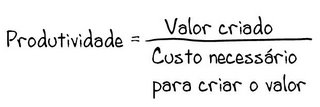"Because you can do something is a dreadful reason for doing that thing. Any broadening of WTP — whether more offerings, more customers, more geographies, more vertical integration (forward or backward) — should only happen if it strengthens HTW; that is, if it increases the intensity of the energy. If it has a neutral effect on HTW, it shouldn’t be done. Tie doesn’t go to the runner. That is because it will spread the energy, which accelerates entropy. If it decreases the power of HTW, it shouldn’t be given a millisecond of consideration. Steve Jobs understood this in spades. When he returned to Apple, he famously hacked and slashed his way through energy-dissipating offerings in order to build energy in the remaining core."
As PME que expandem sem critério acabam a competir no terreno das commodities, onde o único diferencial possível é o preço e a escala, mas as PME não podem competir com grandes players neste modelo, pois não têm poder de compra, produção em massa nem logística eficiente o suficiente para operar com margens muito baixas.
O cliente que procura um produto ou serviço diferenciado não quer uma empresa que "faz tudo". Ele quer uma empresa especialista, que entrega um valor real e uma experiência superior. Isto está directamente relacionado com o ponto do texto sobre preservação da energia do negócio: a Starbucks voltou a crescer cortando excessos e regressando ao essencial, tal como as PME devem evitar o risco de diluir a sua proposta de valor.
Recordo:
- 2015 - Salami slicers
- 2010 - "Just get rid of the crappy stuff and focus on the good stuff."
- 2019 - O paradoxo da escolha, again
Trecho retirado de "Starbucks & Strategic Entropy"
BTW, recordo de 2012:
"By September 1997, Apple was two months from bankruptcy. Steve Jobs, who had cofounded the company in 1976, agreed to return to serve on a reconstructed board of directors and to be interim CEO.
...
What he did was both obvious and, at the same time, unexpected. He shrunk Apple to a scale and scope suitable to the reality of its being a niche producer in the highly competitive personal computer business. He cut Apple back to a core that could survive.
...
Jobs cut all of the desktop models—there were fifteen—back to one. He cut all portable and handheld models back to one laptop. He completely cut out all the printers and other peripherals. He cut development engineers. He cut software development. He cut distributors and cut out five of the company’s six national retailers. He cut out virtually all manufacturing, moving it offshore to Taiwan. With a simpler product line manufactured in Asia, he cut inventory by more than 80 percent. A new Web store sold Apple’s products directly to consumers, cutting out distributors and dealers.
...
The power of Jobs’s strategy came from directly tackling the fundamental problem with a focused and coordinated set of actions. He did not announce ambitious revenue or profit goals; he did not indulge in messianic visions of the future. And he did not just cut in a blind ax-wielding frenzy—he redesigned the whole business logic around a simplified product line sold through a limited set of outlets."

%2013.04.jpeg)
%2006.21.jpeg)













Sem comentários:
Enviar um comentário